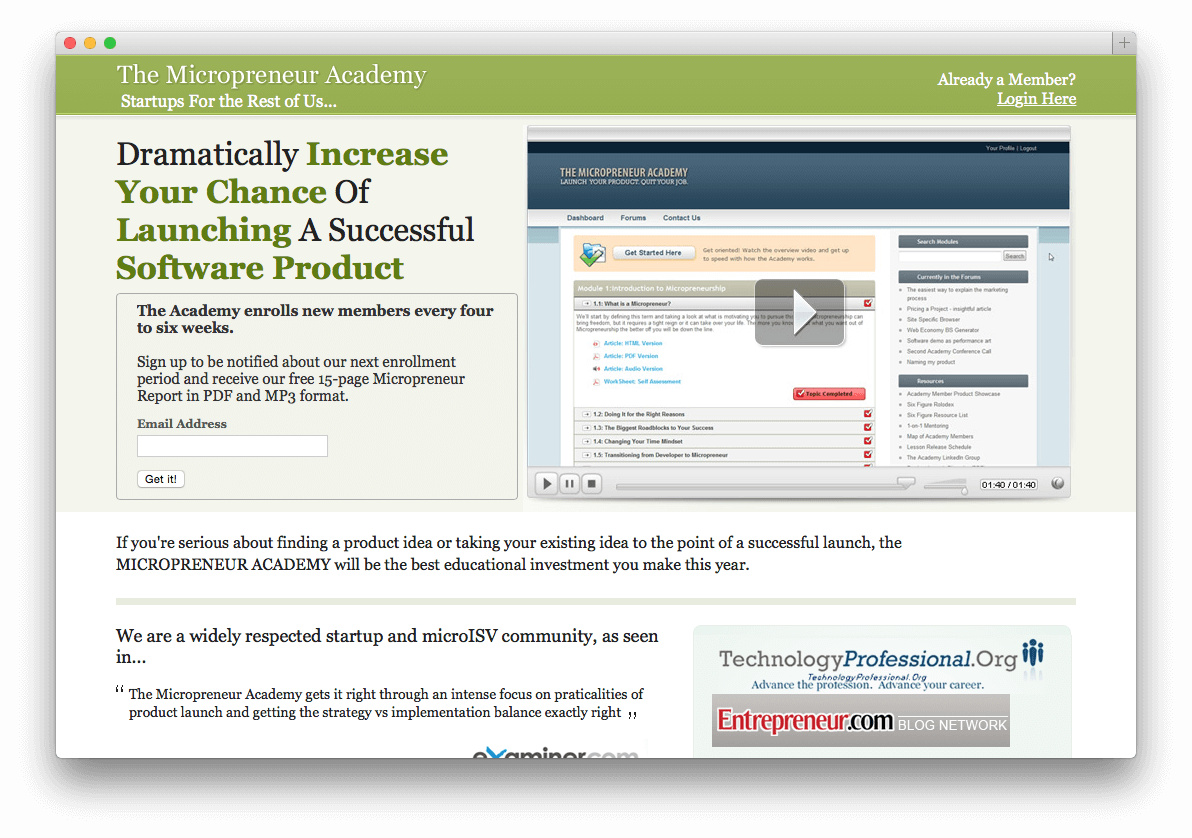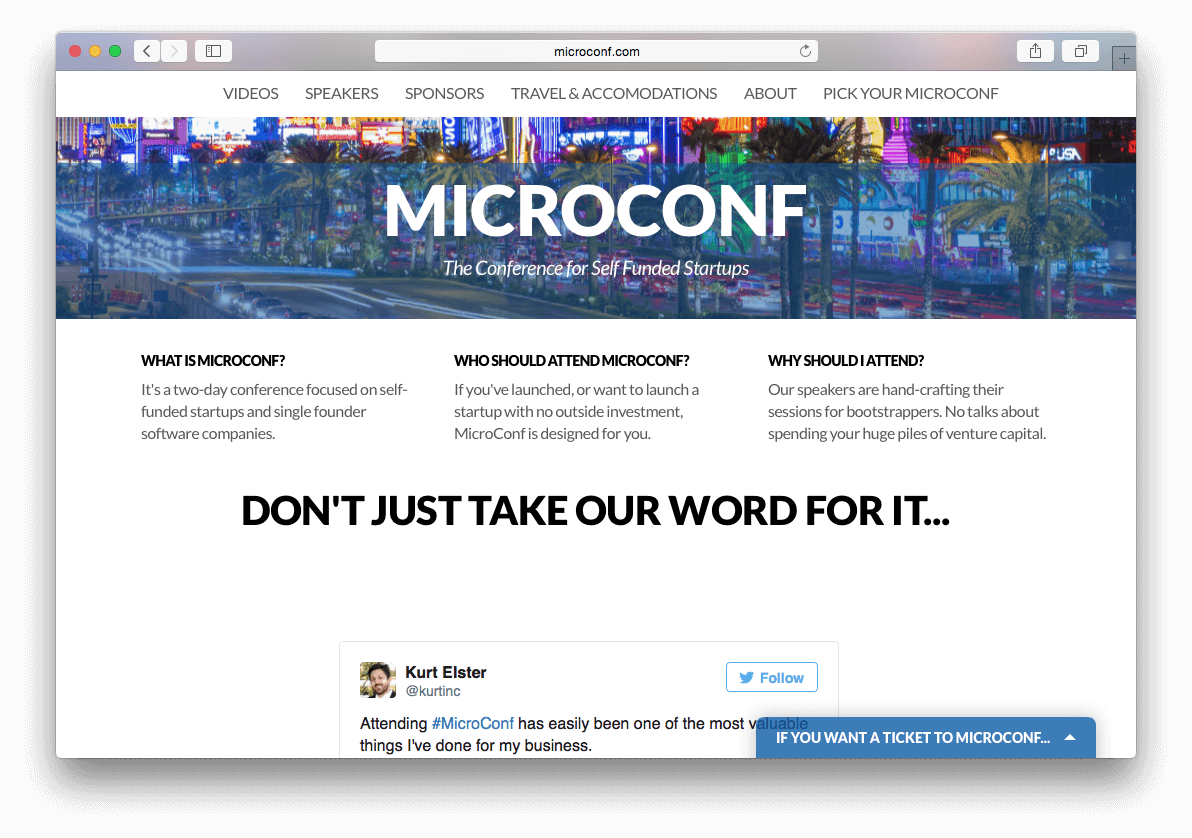Mike Taber co-owns the Micropreneur Academy with Rob Walling. The Micropreneur Academy is a community of bootstrappers around the world.
In this guest post, he describes how they built a community of over 1,000 software entrepreneurs, the challenges they had to overcome, and how Axero fits their needs better than anything else they could find.
Bootstrappers seeking bootstrappers. We started the Micropreneur Academy because we wanted to talk online to other people who were also running self-funded and bootstrapped startups. Neither of us could find anyone local—Mike lived in Massachusetts and Rob was in California.
Online community, v1.0. The first iteration of our online community was essentially a bunch of people subscribed to our WordPress site. Online communities weren’t as prevalent in 2009 as they are today. We heavily optimized our site for SEO and email subscriber acquisition. We talked about the community to people we met in person to get them excited and involved.
Since our community started, nearly 3,000 people have come through the door. We now have about 1,000 active members in the online community.
The Challenges of Running an Online Community on WordPress:
- Upgrades took hours and gave us nightmares. Our site used more than a dozen WordPress plugins to provide the functionality needed for the community. Every time we went through an upgrade, things would break. It often took the expertise of both of us to perform what should have been a simple upgrade. We’d spend upwards of 3 hours on Skype together fixing problems and it became a scheduling nightmare. Eventually, we decided not to upgrade a plugin unless something was actually broken.
- No messaging, no mobile, no good. We encountered a number of problems with the forums from the start. It didn’t look good and the messaging capabilities were terrible. It wasn’t mobile-ready and the search was poorly implemented.
- Engagement was manual. We didn’t have a daily digest. We hired someone to go into the forums and pick out a handful of 8 to 10 forum topics each week, then send out an email to our subscribers. This helped to keep them engaged in the forums but was still a manual effort.
- Slow performance was a turn-off. WordPress is generally pretty slow and it takes a significant amount of technical expertise and testing to make it faster. There were better places to spend our time so we invested in WP Engine which is a fantastic service for making WordPress faster. That helped a lot, but we still took WordPress right to its limit. The speed became more tolerable, but it was still slower than we would have liked.
The Last Straw: Why We Finally Gave Up Our WordPress Forum
We got to a point where the number of complaints about the forums made us consider upgrading that plugin. However, the forums used a plugin called Simple:Press and there was no upgrade path from the version we were on to the latest version. Without a viable upgrade path for the forums, we started evaluating our options. It was too tedious to keep all the plugins functioning properly. We decided that we wanted a robust platform that we wouldn’t have to maintain on our own.
We looked at quite a few options for online learning communities. I must have typed every keyword into Google: Social CRM, Social Intranet, internal collaboration, online classroom. There were forums on steroids, wikis on steroids. We found all kinds of stuff. But at the end of the day, none of it was very good. Much of it seemed like community software built by people who had never run a community before. Axero fit our needs better than anything else.
Introducing FounderCafe – Populated by Bootstrappers, Powered by Axero
We call our online community FounderCafe. It’s a private community where members can collaborate and share ideas.
Here’s what we love about the new FounderCafe on Axero:
- Omnipresent search. People universally tell us how much they love the Search feature. It’s great to be able to search the wiki and all the forums, comments, discussions, and events. All at the same time.
- Social is a familiar face. Axero has a Facebook-y feel to it, which people are intimately familiar with. People post questions, challenges they’re facing and share updates in forums. Others comment. Our members share a lot of private information that they wouldn’t share on a public forum because they know it’s a private community of like-minded people. They might have questions about SEO, or need someone to take a look at a landing page design, or have a paid ad campaign they’re running.
- All the features. Axero had a laundry list of things we could use. Wikis, forums, status updates, integrated chat, etc. Most of the other solutions we looked at had some features but not others. I’ve seen a lot of companies that claim to be the all-in-one solution, but what you end up with is as lot of mediocre tools. Axero is truly comprehensive.
- Allows us to begin repositioning as a premium community. We’d like to move the FounderCafe subscription model away from premium content and community towards the premium community alone. Ten thousand people download our podcast every week. Our in-person conference sells out in 20 minutes. Our existing base of 1,000 members is active in the community, talk to each other and know one another. Community is what drives engagement and we’re doubling down on the community. Axero enables us to move in that direction. If someone wants to post a tutorial on how to do an SEO campaign, or how to do a paid advertising campaign, they can. Other people can then modify it. It’s built on the collective wisdom of our community.
- What happens in FounderCafe, moves to MicroConf and back. In 2011, we started a conference for self-funded and bootstrapped entrepreneurs called MicroConf. We wanted a chance to connect with the people in our community in person. It turned out hundreds of people wanted the same thing. We run MicroConf twice a year. Once in Las Vegas in the spring, and again in Europe in the fall. Discussions that people have at MicroConf are continued inside of FounderCafe and vice versa.
How We Invite People Into the MicroConf Community
Not everyone attending MicroConf is a member of the private FounderCafe community. We show them what the private community is like by using Axero to invite MicroConf attendees in advance of each conference. Here’s how we do it:
- We set up a special space inside of our Axero account just for the conference.
- Then we create accounts for every attendee and send out emails with their login instructions.
- Next, we ask people to set up a profile and introduce themselves. Those introductions kickstart conversations.
- People see other entrepreneurs who are doing similar things and start to connect. They have access to that space in the weeks leading up to the conference and for about a month after the conference. By the time the event happens, they’ve already gotten those “Hi, my name is” interactions out of the way.
3 Ways We’re Winning On Axero
- Much faster performance. Axero is fast. Really fast. It’s nice to be able to just go in there and have the page pop up, especially when you compare it to something like WordPress. The forums are responsive and search spans across everything.
- People are more engaged. People can add new posts, like comments and add tags. They find that helpful. We know this because they say things like, “I love that I can do this!”
- We’re getting truly personal support. I’m truly impressed the support we get from the Axero team. When we have a problem, the level of attention we get is really high. It’s a welcome change to be able to say, “Hey, I really need help with this. Can you jump in?” We don’t generally have to wait long. Support is very, very good.
So, You Want to Start an Online Community?
Advice to other online community founders:
- Turn people away. If you’re building a community, the natural inclination is to take anyone so you can reach critical mass. We think you should do the opposite. Focus on turning specific people away who are not a good fit using language. For example, “MicroConf is the conference for self-funded software entrepreneurs and bootstrappers.” When you accept everyone into your community, you get a lot of people, but they don’t have much in common. That crowd becomes unwieldy once you reach a tipping point. It’s not that they’re rambunctious. It just becomes difficult to change the direction or focus of the community. Early adopters and “old timers” will feel entitled to having the community run in a certain way.
- Let new members join on a scheduled basis, not anytime they feel like it. We only let new members join as part of a new incoming class. If you let people join whenever they feel like it, your conversion rates will plummet. We experienced a 75% drop in subscriber rates by opening the doors to everyone whenever they felt like joining. A side effect of this is that when someone does join, they’ll feel like they’re the only one who showed up to the party. If a lot of people are coming in the door at the same time, there’s a sudden influx of new blood in the community. This will help to jumpstart existing and new discussions. Launching a community is just like launching software. Timing is everything.







